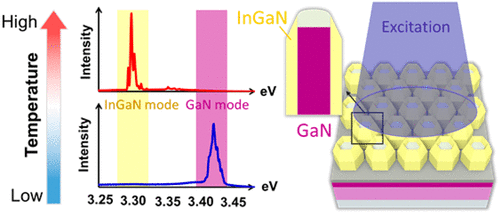当前位置:
X-MOL 学术
›
ACS Photonics
›
论文详情
Our official English website, www.x-mol.net, welcomes your feedback! (Note: you will need to create a separate account there.)
Mode-Hopping Phenomena in the InGaN-Based Core–Shell Nanorod Array Collective Lasing
ACS Photonics ( IF 7 ) Pub Date : 2018-06-19 00:00:00 , DOI: 10.1021/acsphotonics.8b00471 Chia-Yen Huang,Tzu-Ying Tai,Jing-Jie Lin,Tsu-Chi Chang,Che-Yu Liu,Tien-Chang Lu,Yuh-Renn Wu,Hao-Chung Kuo
ACS Photonics ( IF 7 ) Pub Date : 2018-06-19 00:00:00 , DOI: 10.1021/acsphotonics.8b00471 Chia-Yen Huang,Tzu-Ying Tai,Jing-Jie Lin,Tsu-Chi Chang,Che-Yu Liu,Tien-Chang Lu,Yuh-Renn Wu,Hao-Chung Kuo

|
A two-dimensional monolithic InGaN-based core–shell nanorod array was excited under a varying temperature. We observed an abrupt dominant mode hopping from 3.29 to 3.41 eV in the collective lasing as the temperature decreased from T = 240 to 225 K. Photoluminescence under a near-threshold pumping density revealed the splitting of spontaneous emission between the core and the shell with a decreasing temperature. The bandgap evolution of GaN and InGaN showed opposite trends due to the interaction of temperature effects and bandgap renormalization effects. Theoretical simulation revealed the differences of gain spectra evolution between room temperature and low temperature due to the difference in the carrier dynamics. In the optically coupled nanorod array, the dominant lasing mode was not only determined by its structure, but also strongly influenced by external operating conditions. Rather than singular microcavity lasers, the coupled nanorod array demonstrated a broader parameter space for on-chip wavelength manipulation.
中文翻译:

基于InGaN的核-壳纳米棒阵列集体激射中的模式跳跃现象
二维单片InGaN基核-壳纳米棒阵列在变化的温度下被激发。我们观察到随着温度从T下降,集体激光中的突然主导模式从3.29 eV跃升至3.41 eV。= 240至225K。在接近阈值泵浦密度下的光致发光表明,随着温度的降低,核与壳之间的自发发射发生分裂。由于温度效应和带隙重归一化效应的相互作用,GaN和InGaN的带隙演化显示出相反的趋势。理论仿真表明,由于载流子动力学的差异,室温和低温之间增益谱演化的差异。在光耦合纳米棒阵列中,主要的激射模式不仅由其结构决定,而且还受到外部工作条件的强烈影响。耦合的纳米棒阵列不是奇异的微腔激光器,而是为芯片上的波长操纵展示了更宽的参数空间。
更新日期:2018-06-19
中文翻译:

基于InGaN的核-壳纳米棒阵列集体激射中的模式跳跃现象
二维单片InGaN基核-壳纳米棒阵列在变化的温度下被激发。我们观察到随着温度从T下降,集体激光中的突然主导模式从3.29 eV跃升至3.41 eV。= 240至225K。在接近阈值泵浦密度下的光致发光表明,随着温度的降低,核与壳之间的自发发射发生分裂。由于温度效应和带隙重归一化效应的相互作用,GaN和InGaN的带隙演化显示出相反的趋势。理论仿真表明,由于载流子动力学的差异,室温和低温之间增益谱演化的差异。在光耦合纳米棒阵列中,主要的激射模式不仅由其结构决定,而且还受到外部工作条件的强烈影响。耦合的纳米棒阵列不是奇异的微腔激光器,而是为芯片上的波长操纵展示了更宽的参数空间。



























 京公网安备 11010802027423号
京公网安备 11010802027423号